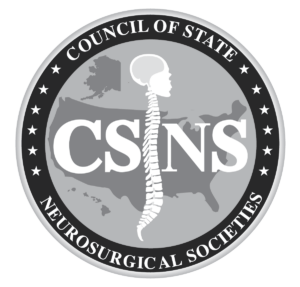About US
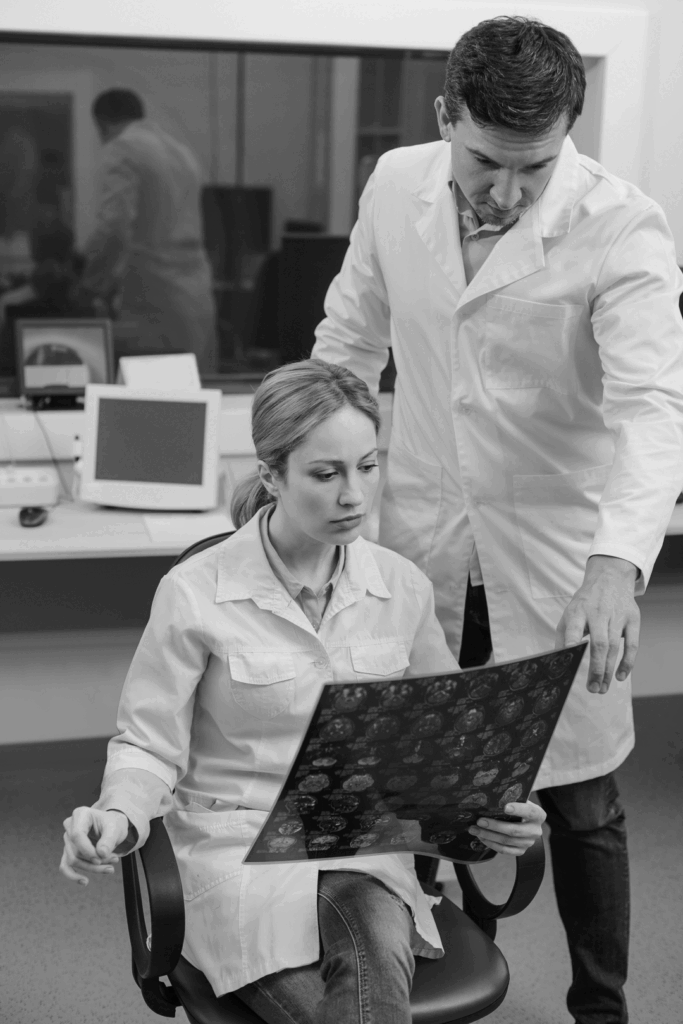
History of the Council of State Neurosurgical Societies
Purpose
The CSNS is a representative, deliberative and collaborative organization of delegate neurosurgeons in training and practice that exists to:
- Positively influence and affect the socioeconomic policy of organized Neurosurgery for the benefit of Neurosurgical patients and the profession,
- Serve as a resource for socioeconomic knowledge and education for Neurosurgeons, regulatory and health care officials as well as legislative representatives,
- Provide a conduit for new initiatives, concerns and issues to be brought to the American Association of Neurological Surgeons and Congress of Neurological Surgeons for response and action, and
- Provide an environment for developing future leaders in healthcare policy and advocacy for Neurosurgery.
The CSNS believes that the specialty of Neurosurgery stands for the highest quality of care and that neurosurgeons are their patients’ strongest advocates. The following highlights the development and sentinel events in the birth and subsequent maturation of the CSNS that contribute to the effective body it has become.
The Seed
Regional, national and international neurosurgical societies were formed predominantly in the first half of the 20th century to disseminate advances in neurological surgery and to promote research. With the expansion of third party payers and the advent of Medicare in the 1960s, socio-economic issues began to impinge on the practice of neurosurgery and could not be ignored.
In response to Blue Shield initiating relative value scales in various states, the Congress of Neurological Surgeons (CNS) established a Socio-Economics Committee in 1963 under the Chairmanship of the late Dr. William Mosberg. This committee, composed of appointed members representing as many different states as possible, surveyed neurosurgeons and published the first Neurosurgical Fee Survey in 1966 and Neurosurgical Utilization Guidelines in 1969.
Origination
The oldest Neurosurgical Society, the Society of Neurological Surgeons, otherwise referred to as “the Senior Society”, had an influence on AANS leaders as many of these individuals had membership or aspirations of membership in this elite society. In the Senior Society’s founding charter, socioeconomic matters were noted to be private matters between doctors and their patients. As a result of this influence AANS leaders were of the opinion that discussions of socioeconomic issues were beneath the dignity of a society primarily concerned with research and education. After considerable deliberation and arm-twisting, the American Association of Neurological Surgeons (AANS) reluctantly joined the CNS in forming the Joint Socio-Economics Committee (JSEC) in 1972. The initial Joint Socio-Economics Committee (JSEC) had co-chairmen with Dr. Russel H. Patterson, Jr. appointed by the AANS and Dr. Edwin Amyes appointed by the CNS. Dr. George Ablin was the first Secretary. In this original JSEC, members were appointed by the presidents of the AANS and CNS.
Maturation
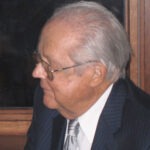
In 1972 the United States Congress passed the Professional Standards Review Organization (PSRO) law establishing review organizations in each state to monitor medical care. The JSEC and the AANS/CNS recognized the need for individual state neurosurgical societies to interact with these PSROs. At the AANS meeting in the spring of 1973, JSEC, with the support of AANS President Bill Meacham and CNS President Bernard Patrick, appointed an advisory group of geographically diverse neurosurgeons to meet under the guidance of Drs. Amyes, Patterson and Ablin. This advisory group served to facilitate the formation of state societies to interact with the PSROs and provide input to the JSEC regarding local and regional economic issues. Thirty seven neurosurgeons representing a majority of the states met at the O’Hare Airport on June 23, 1973. This group chose to name itself the National Advisory Group and elected Dr. Frank Wrenn as chairman. At this first meeting, the attendees divided themselves into four regions, the Northeast, Northwest, Southeast and Southwest, in order to facilitate information transfer and regionally assist each other in the formation of state societies.
The National Advisory Group, under the leadership of Dr. Wrenn, promoted the establishment of state neurosurgical societies in states without them. There were 21 state neurosurgical societies in existence in September, 1974, with ultimate expansion to 37. Eight additional states are in two regional societies, the Midwest Neurosurgical Society (Nebraska, Iowa, South Dakota & Kansas) and the New England Neurosurgical Society (Connecticut, Maine, Massachusetts & New Hampshire). All eight states have delegate positions in the CSNS.
The National Advisory Group was under the umbrella of the Joint Socio-Economics Committee and reported to it. The National Advisory Group would meet during the JSEC meeting twice each year. In 1974, JSEC decided to have its meetings just before rather than during the AANS and CNS annual meetings and the NAG moved to that time slot as well. The National Advisory Group initially had its membership appointed by JSEC but as it evolved, each state society began to send representatives to the National Advisory Group meetings as delegates. The National Advisory Group changed its name to the Council of State Neurosurgical Societies (CSNS) in 1976 and formalized the elected state delegate concept. JSEC appointed Edwin Amyes the first Chairman of the CSNS in 1977 and the CSNS held its first formal meeting in 1978.
AANS Board of Directors Representation
The Council formalized the four quadrant division of the group and structured many of its procedures upon the activities of the quadrant chairpersons. In 1982 JSEC and the CSNS recommended an AANS by-laws change to create four regional AANS Board Directors, one elected from each CSNS quadrant and in 1983 the AANS by-laws were so amended. Regional nominees elected by the four quadrants are provided to the Nominating Committee of the AANS and these individuals are then voted upon by the AANS membership to seats on the AANS Board of Directors for terms of 3 years.
JSEC - CSNS
The Council of State Neurosurgical Societies initially functioned as a committee of and reported to the Joint Socio-Economics Committee and met as part of each JSEC meeting. Because the scope of CSNS socioeconomic interests was so wide, its meetings became a substantial part of the JSEC meetings and the Council developed its own set of officers including a treasurer to oversee the Council’s separate budget. It became clear that the Council was functioning as more than a committee of the JSEC.
IN 1984, the CSNS perceived that consolidation of the CSNS and JSEC would serve to avoid duplicative efforts by similar committees in each body. Responding to recommendations of the AANS Executive and Long Range Planning Committee and the CNS Executive Committee, the JSEC/CSNS organizational structure was streamlined in1986 and became the Joint Council of State Neurosurgical Societies (JCSNS). This body established a single set of officers and a membership composed of delegates elected from each state society plus delegates appointed by the parent bodies. In 1998, the council simplified its name to the Council of State Neurosurgical Societies (CSNS). It functions as a joint committee of the AANS and CNS much as the AANS/CNS Washington Committee and the various subspecialty joint committees.
Conversion to a Representative Assembly


The early CSNS meetings were marked by adequate information exchange but recommendations by the CSNS to the parent bodies were frequently the result of issues brought up during the meetings and acted upon with limited time for study or refinement.
In 1995, at the instigation of CSNS Chairman Stan Pelofsky and Vice-Chairman Jim Bean, the CSNS adopted procedures requiring it to act as a representative assembly with a well defined resolution process mandating pre-meeting submission of resolutions and their study by appropriate committees prior to consideration at the actual CSNS meeting.
Formation of a Political Action Committee & Development of Neurosurgery's 501(c) 6 Corporation
Recognizing the effects on Neurosurgical practice and Neurosurgical patient access to appropriate Neurosurgical care by the actions of government and the legislative bodies of the United States Congress, JCSNS members brought forward a resolution in 1990 to teach neurosurgeons proper lobbying methods. In 1993 a JCSNS resolution passed requesting the Washington Committee engage a professional firm for representation of neurosurgeons in major economic lobbying efforts. In 1993 the JCSNS passed a resolution recommending to the Board of Directors of the AANS and the Executive Committee of the CNS that a national neurosurgical political action committee be created. This led to the formation of ANSPAC (American Neurosurgical Society Political Action Committee) in 1997 which functioned as an independent, unaffiliated PAC from 1997 to 2005 when it was dissolved.
Both parent organizations were 501(c)3 organizations. This limited the organizations from engaging in political action and political fund raising. The CSNS passed a resolution in 2002 with the resolve that the AANS and CNS create a 501(c)(6) organization for all of neurosurgery, not only to support the Washington Committee and the Neurosurgical PAC, but also as an integral part of a true merger of the two organizations to meet the critical needs of our profession. The Board of the American Association of Neurological Surgeons (AANS) recommended a bylaws change that enabled establishment of a companion organization to operate under Section 501(c)(6) of the Internal Revenue Code. Members of the AANS approved the bylaws change in the summer of 2003. This action broadened the AANS functionality from that of an entity with the primary purpose of education and research, organized under Section 501(c)(3) of the Internal Revenue Code, to an entity that additionally has the freedom to coordinate political activities and sponsor major income generating programs, organized under Section 501(c)(6). NeurosurgeryPAC was established in 2005 with the dissolution of ANSPAC and in concert with the formation of the 501(c) 6 Corporation. It is directly affiliated & sponsored by the AANS and has significant advantages over an independent political action committee.
Resident Fellowships
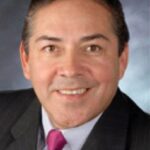
Dr. David Jimenez attended the 1994 meeting of the JCSNS as an alternate delegate. He found that the socioeconomic subject matter discussion was foreign and not something to which he had been exposed. He contacted many other young neurosurgeons who also expressed that the subject matter of socioeconomics was not anything for which they had gained any knowledge. This led to an educational effort subsequently made available to neurosurgeons and neurosurgical residents. As a consequence of Dr. Jimenez’ attention to the need for socioeconomic education, particularly for residents and the attention this generated, the Young Neurosurgeons Committee brought forth Resolution 1 at the Autumn 1998 CSNS meeting. Twelve one year Resident Fellowships, three from each Quadrant, to the CSNS were established and the first class of fellows matriculated in 1999. This provides an opportunity for Residents in training to gain exposure and knowledge in socioeconomic issues. Each resident fellow is appointed a CSNS mentor and is tasked with projects. The resident fellow presents his/her work before the council during a Plenary session.
Medical Student Summer Fellowships
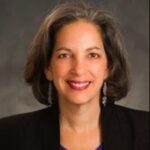
Recognizing the value of the Resident Fellowships, in 2006, Dr. Deborah Benzil introduced the concept of providing medical students with neurosurgical interests an opportunity to participate in socioeconomic research. The CSNS/CNS Medical Student Socioeconomic Fellowship supports a medical student conducting research on a socioeconomic issue impacting neurosurgical practice. It is funded and overseen by the Council of State Neurosurgical Societies and administered through the Fellowship Committee of the Congress of Neurological Surgeons.
The fellowship is open to all medical students in the United States and Canada. The fellow will spend 8 to 10 weeks conducting supervised research on a socioeconomic topic of importance to neurosurgery. The first CSNS/CNS medical student fellow performed the fellowship in 2008.
Redesign

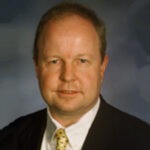
Sensing the changing times and a need for CSNS change to meet the growing socioeconomic issues affecting Neurosurgery, a Strategic Planning retreat was held March 23-24 2007 to examine the missions and functions of the CSNS. Dr. Gary Bloomgarden became Chair of the Council during this time and led the process for redesign. A new Mission and Vision statement of the CSNS emerged from this strategic planning initiative. This statement acknowledged the fact that the CSNS had evolved beyond a simple communication and resolution conduit to its parent organizations into a body with year-round standing committee socioeconomic and health policy work. The CSNS serves as the primary source for socioeconomic and health policy educational expert input and educational product development for its parent organizations, and development of future organized neurosurgery socioeconomic and health care policy leaders. In order to effectively fulfill the newly-defined mission as well realize the larger organizational vision, changes were needed in organizational structure to facilitate and insure optimal organizational function. The CSNS Rules and Regulations Committee addressed the needed changes in accordance with the CSNS Organizational White Paper presented by Dr. Mark Linskey at the Spring, 2009 CSNS meeting. Multiple CSNS Rules and Regulation changes were formulated into specific formal change proposals. These Rules and Regulations changes were adopted by the CSNS body during the Fall 2009 CSNS meeting.
Proceedings
The Council meets twice a year just before the annual meetings of the AANS and the CNS during which it considers resolutions submitted by delegates or its committees and receives reports from those committees as well as the AANS and CNS. Resolutions that are adopted by assembly vote are sent to the AANS/CNS for consideration and potential implementation.
Throughout its years of existence, the grass roots concept embodied at first by the National Advisory Group and subsequently by the Council of State Neurosurgical Societies has functioned well as egalitarian input into the generally hierarchical leadership of the AANS and CNS. In the early years of CSNS activities, the parent bodies may have characterized the grass roots input in terms of the National Advisory Group’s acronym used as a verb but there has never been any wavering of support from the AANS and CNS for the concept of a CSNS and the Council’s budget which now approaches 175K a year. The Council does not function as a policy setting body like the AMA House of Delegates and that leaves the Executive Committee of the CNS and the Board of Directors of the AANS considerable leeway and greater nimbleness to steer the neurosurgical ship. The Council does cover a lot of socioeconomic ground upon which the parent bodies rely and for which the AANS and CNS have expressed their gratitude. The CSNS continues to have the ear of its parent bodies and will continue to pursue the concerns of the neurosurgeon in the trenches. This forum is the single most direct pathway for an issue affecting Neurosurgical patients and Neurosurgical practice to be brought forward to organized medicine in order to enact action.
Submitted by John M. Thompson, M.D.
Former Secretary of JSEC and JCNS
Edited by Randall Smith, M.D., CSNS Historian
September, 2008
Edited by Hasan Zaidi, Luis Tumalian and CSNS Historian, Clarence B. Watridge
July 2015

